Making Manufacturing Great Again? Should Australia and Donald be on the same page?
MOST Australians agree with Donald Trump about one key economic issue. There’s just one problem: they’re all wrong. Here’s why.
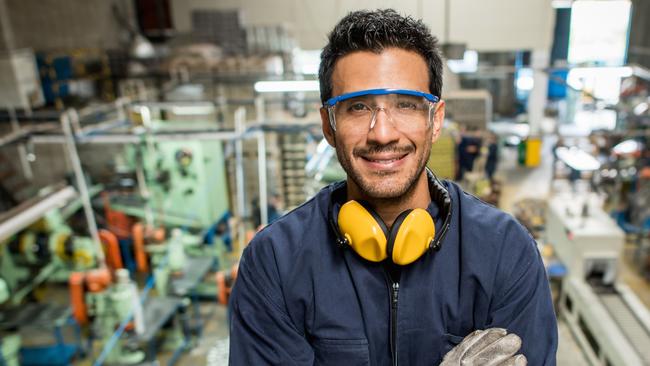
MOST Australians agree with Donald Trump on one thing. They want more manufacturing jobs.
According to a recent survey by Fairfax, 83 per cent of Australians seem to agree with him — they think we should import less and make more things in Australia. It was the thing Aussies agreed on most.
I support manufacturing. It is fine. But I don’t support it being the only thing we can agree on. There is nothing particularly special about manufacturing. If we spend all our energy trying to bring back manufacturing jobs, we will miss out on much better jobs.
Here’s the truth about manufacturing: it is becoming a smaller and smaller part of the economy of the whole world, as this next graph shows.
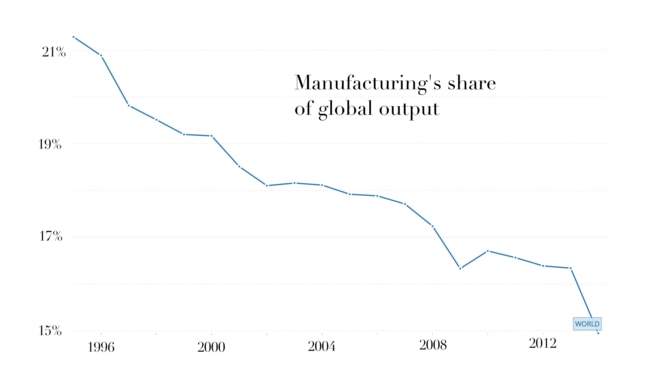
If we fight over the shrinking share, we miss the chance to win the growing share. That growing share is services. The boom in services jobs is a side effect of the whole world getting richer. When people are poorer, what they buy is limited to food and water, shelter, furniture and clothing. As the world gets richer those things are still needed, but they become a smaller share of people’s budgets. Instead, they buy things like holidays, health services and education.
In Australia, that trend away from buying physical possessions is very clear.
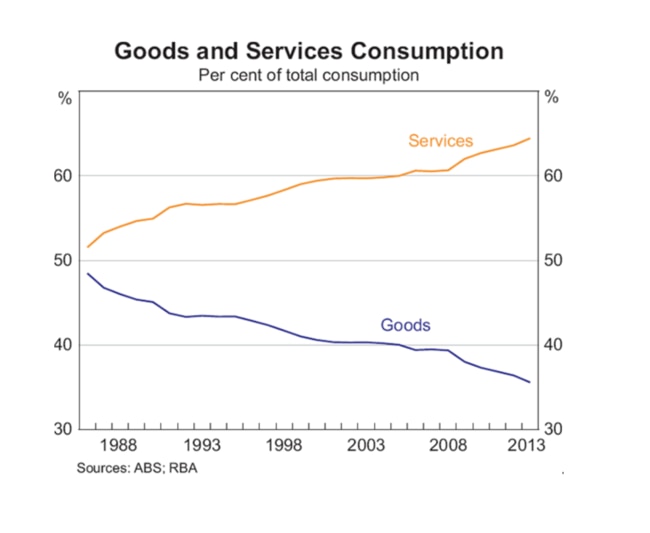
The richer a country is, the more it comes to rely on the hairdressers, the taxi drivers, the insurance gurus.
This next graph shows how several countries have grown their services sector as they get richer.
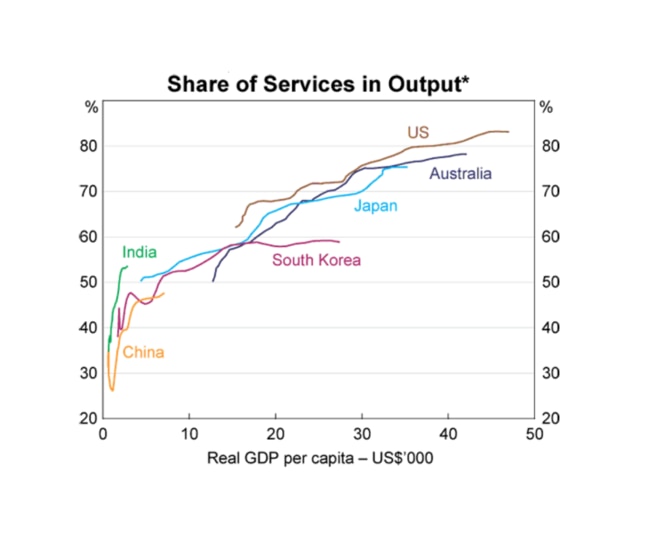
Have no doubt — the richer we are, the bigger the services sector will get. This is good news for the economy. Most jobs are services jobs and they have been for some time.
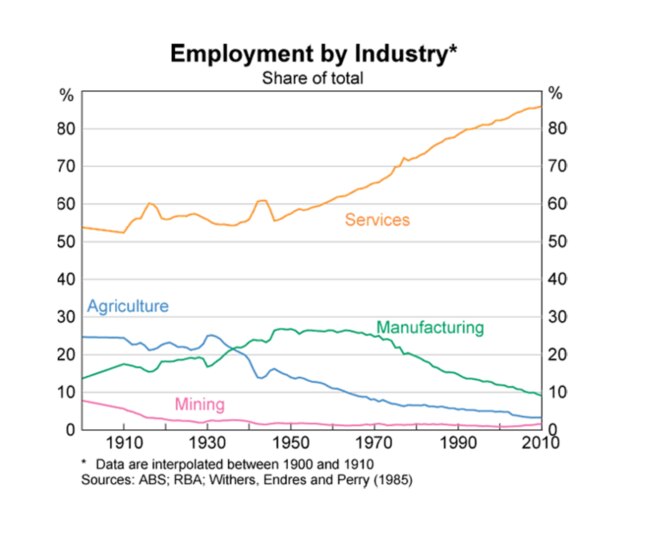
MEET JIM AND TOM
For much of history manufacturing had an advantage. You could put things on ships and sell them everywhere. It was the only way to get lots of exports. These days, we can export services. Tourism counts as an export, (selling Australian work to foreigners) and it is becoming a giant part of Australia’s economy.
Some people feel a bit dubious about tourism. They feel like it is not really a good way to make money. Those people should meet Jim and Tom.
Jim makes bikes and sells them. Tom has a bike rental business. Jim is the manufacturing industry. Tom is the services sector.
Both have a positive impact on the local economy. Both use their revenues to pay for land, staff, insurance, supplies, advertising, materials. Some of it is imported and some is made locally.
Jim can be put out of business by an offshore competitor that makes bikes cheaper. But Tom can’t easily be put out of business by a foreign competitor. In fact, the cheaper China makes bikes, the easier it is for Tom to run his business.
As more and more tourists come to Australia, Tom’s bike rental business can get bigger and bigger.
The same goes for education, and lot of other services. This is already happening — for example, Australian architecture firms and software design companies are selling their product all over the world.
MANUFACTURING IS NOT MEAT AND POTATOES
Some Aussies seem faintly ashamed of having a strong services sector. As if manufacturing is real, but services are a fake sort of economy, weak and fragile. They hold this belief even as they aspire for their children to work in the services sector as doctors or lawyers, teachers or software engineers.
There is a simple logic for why we might have been fooled into being ashamed of services. But we need to unlearn that logic.
Humans have a physical hierarchy of needs. The most fundamental parts are water, food and shelter. Physical things.
It’s easy to imagine the economy works the same way. That if making physical things becomes a minor part of the economy, it dies. You can imagine that an economy that’s all education and tourism, music and yoga, is an economy that is not nourished and starves to death.
It’s tempting to believe. Problem is there is a lot of evidence against it. Those charts above show countries with booming services are the richest ones.
SURE, WE *COULD* FIGHT THE ROBOTS …
Growing your manufacturing is a stage in a country’s evolution. Australia grew manufacturing until the 1970s. Likewise, China grew its manufacturing to take it from total starvation-level poverty to simply being a low-income country. After that, you need to rely on other industries.
So much manufacturing can be done by low-wage people or by robots. A country obsessed with manufacturing has to keep one eye on Bangladesh and the other on an increasingly intelligent army of precision robots that never get tired.
I’m not saying Australia can’t have manufacturing. We should have some. We make great food products and we can do some local making of things. But we need to drop the idea that we will go back to some sort of 1960s idyll where manufacturing props up our whole economy. That time is over.
Look at this next chart. Jobs growth is coming from industries that help people, not industries that make things.
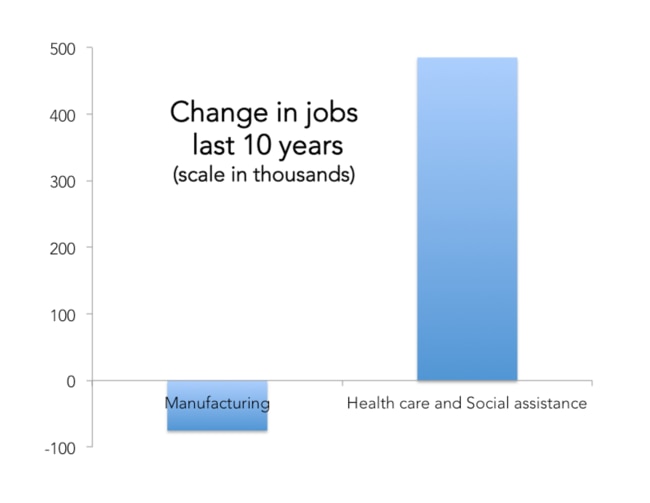
Why do I care about this? Why stir up the 83 per cent of people who love manufacturing when their only mistake is to have a fondness for factories?
The answer is in the above chart. If we focus on the wrong sectors, we will miss out on making Australia wealthy. If we focus on the boom sectors, we can make sure there is lots of work to go round.
Jason Murphy is an economist. He publishes the blog Thomas The Thinkengine. Follow Jason on Twitter @Jasemurphy




